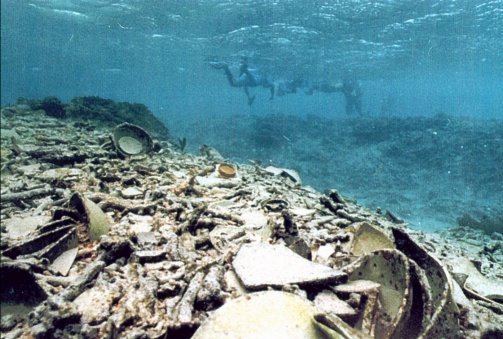|
We have established conventions in areas of the protection of cultural heritage in the
event of armed conflict, preventing illicit traffic, protection of the "world heritage", and the
return of stolen cultural property. We also have some important international organizations working
on the protection of cultural heritage, such as UNESCO. However, all of the above focus only on
land-based heritage. We still have no international convention or international organization for the
protection of underwater cultural heritage, an area in much greater need of protection in the
interest of humanity.
What kind of underwater cultural heritage convention do we need? Needless to say, some
underwater cultural heritage lies in internal waters, archipelagic waters, and the territorial sea.
As one of the principles of such a convention, states have the duty to protect this heritage in the
interest of humanity; they must take all necessary measures to prohibit and prevent its illicit
excavation and commercial exploitation and establish standards for the protection and management of
underwater cultural heritage. These should be formulated by the appropriate international
organization. A future convention should stress the duties in these areas of the States Parties.
Much of the underwater cultural heritage is in the Exclusive Economic Zone (EEZ) and on the
continental shelf. In addition, much of it entirely escapes any national control, since it is located
on the outer reaches of the continental shelf or deep seabed. What can future convention do about
this part of the underwater heritage?

We must refer once again to the United Nations Convention on the Law of the Sea, "the culmination
of over 14 years of work involving participation by more than 150 countries representing all regions
of the world, all legal and political systems, all degrees of socio-economic development." The Law of
the Sea Convention was not written specifically to apply to underwater cultural heritage and has only
two provisions that pertain to it: "States have the duty to protect objects of an archaeological and
historical nature found at sea and shall cooperate for this purpose" (Article 303(1) of the General
Provisions of the Convention); and "All objects of an archaeological and historical nature found in
the Area shall be preserved or disposed of for the benefit of mankind as a whole, particular regard
being paid to the preferential rights of the State or country of origin, or the State of cultural
origin, or the State of historical and archaeological origin" (Article 149 of the Convention on the
Area, which basically means the deep seabed). Of course, these provisions are not sufficient for the
protection of underwater heritage and will not be the general principles of the future convention,
but they are very important ideas demonstrating the universal basic reaction to the underwater
heritage.
In fact, it is necessary for a future convention to clearly define the following principles. The
cultural heritage in the EEZ, on the continental shelf, and in the Area (meaning the seabed under the
high seas), belongs to humanity. No State shall claim or exercise sovereignty over the cultural
heritage. All rights in cultural heritage are vested in humanity as a whole, on whose behalf the
appropriate international organization shall act. Cultural heritage is not subject to alienation, and
cultural heritage recovered from these areas may be alienated only in accordance with the future
convention and the rules, regulations, and procedures of the related international organization. The
rules and regulations of the related international organization shall pay particular attention to the
preferential rights concerning cultural heritage of the coastal state in the EEZ and on the
continental shelf and the preferential rights of the state of cultural origin for the cultural
heritage in the Area. States Parties shall have the responsibility of ensuring that activities
affecting the cultural heritage, whether carried out by States Parties or by natural or juridical
persons that possess the nationality of States Parties or are effectively controlled by them or their
nations, shall be carried out in conformity with a future convention. The same responsibility applies
to international organizations for activities they carry out that affect the cultural heritage.
Thus, the protection of the underwater cultural heritage, especially that heritage lying outside
of national control, requires an international organization. Because the exploration of underwater
heritage demands much more information and a much higher level of technology than does the
exploration of land-based heritage, it is much more difficult for States to prohibit and prevent the
illicit excavation and commercial exploitation of the underwater heritage than it is to protect
land-based heritage. Because large corporations from the developed countries have not been able to
protect the heritage in the EEZ, on the continental shelf, and on the deep seabed in the interest of
all humanity, and because it is necessary that "particular regard be paid to the preferential rights"
of the State of origin, UNESCO should cooperate with the International Seabed Authority (ISA) to
establish an underwater cultural heritage center.
In the new century, people will think more highly of the protection of cultural heritage, and at
the same time, the underwater cultural heritage will face even greater threats from even more
sophisticated underwater technology. The duty of the State regarding this protection will be much
more clearly defined, and a special international organization will protect the common heritage in
the name of humanity. We need this kind of convention.
There are in total about 20,000 underwater archaeological sites in China. As on land, some of the
underwater cultural heritage is also illegally excavated. At the beginning of 1999, archaeologists
working underwater near Huaguang Island of the Xisha Islands in the South China Sea discovered a
historic shipwreck of the Song Dynasty (AD960-1279) together with a large area of drifted
antiquities. To their surprise, they also found two large holes made by explosives, which had also
seriously damaged other parts of the site. It is thought that this attack probably happened several
years ago. This archaeological site is located so far from the mainland that it draws attention to
the serious situation of the underwater archaeological heritage of China . .
Mr He Shuzhong
Cultural Heritage Watch (CHW),
Beijing, China
October, 1999
|